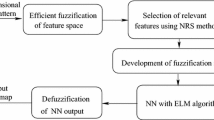Abstract
In this paper, we take an interest in representation and treatment of imprecision and uncertainty in order to propose an original approach to approximate reasoning. This work has a practical application in supervised learning pattern recognition. Production rules whose conclusions are accompanied by belief degrees, are obtained by supervised learning from a training set. The proposed learning method is multi-featured, it allows to take into account the possible predictive power of a simultaneously considered feature conjunction. On the other hand, the feature space partition allows a fuzzy representation of the features and data imprecision integration. This uncertainty is managed in the learning phase as well as in the recognition one. To introduce more flexibility and to overcome the boundary problem due to the manipulations of membership functions of fuzzy sets, we propose to use a context-oriented approximate reasoning. For this purpose, we introduce an adequate distance to compare neighbouring facts. This distance, measuring imprecision, combined with the uncertainty of classification decisions represented by belief degrees, drives the approximate inference.
The proposed method was implemented in a software called SUCRAGE and confronted with a real application in the field of image processing. The obtained results are very satisfactory. They validate our approach and allow us to consider other application fields.
Similar content being viewed by others
References
H. Akdag, Une approche logique du raisonnement incertain, Thèse de doctorat d'état, Université Pierre et Marie Curie (December 1992).
H. Akdag and D. Pacholczyk, Symbolic treatment of hierarchical questionnaires, in: Proceedings of WOCFAI'91, eds. M. De Glas and D. Gabbay (Angkor, Paris, 1991).
H. Akdag, M. De Glas and D. Pacholczyk, A qualitative theory of uncertainty, Fundamenta Informaticae 17 (1992) 333-362.
M. Benasayag, H. Akdag and C. Secroun, Peut-on penser le monde? Hasard et incertitude (Editions du Félin, Paris, 1997).
A. Borgi, Apprentissage supervisé par génération de règles: le système SUCRAGE, PhD Thesis, Université Pierre et Marie Curie (January 1999). 86 A. Borgi, H. Akdag / Knowledge based supervised fuzzy-classification
A. Borgi, J.-M. Bazin and H. Akdag, Classification supervisée d'images par génération automatique de règles (Cinquièmes Rencontres de la Société Francophone de Classification, Lyon, 1997).
A. Borgi, J.-M. Bazin and H. Akdag, Supervised classification by automatic rules generation, in: The Fourth World Congress On Expert Systems, Application of Advanced Information Technologies, Mexico (1998).
A. Borgi, J.-M. Bazin and H. Akdag, A numerical approach to approximate reasoning via a symbolic interface. Application to image classification, in: Fuzzy-Neuro Systems'98, Computational Intelligence, Munich (1998).
A. Borgi and H. Akdag, Induction supervisée de règles: le système SUCRAGE, in: Conférence d'Apprentissage, CAP'99, Plate-forme AFIA, Paris (June 1999).
B. Bouchon-Meunier, La logique floue et ses applications (Addison-Wesley, Paris, 1995).
M.L. Ginsberg, Multivalued logics: a uniform approach to reasoning in artificial intelligence, Computational Intelligence 4 (1988) 265-316.
D. Heckermans, Probabilistic Interpretations for MYCIN' certainty factors, in: Uncertainty in Artifi-cial Intelligence, eds. L.N. Kanal and J.F. Lemmer (North-Holland, 1986).
Y. Kodratoff and E. Diday (eds.), Induction symbolique et numérique à partir de données, Vol. 1 (Cépaduès-Editions, 1991).
T. Law, H. Itoh and H. Seki, Image filtering, edge detection, and edge tracing using fuzzy reasoning, IEEE Transactions on Pattern Analysis and Machine Intelligence 18(5) (1996).
R.S. Michalski and R.L. Chilausky, Knowledge acquisition by encoding expert rules versus computer induction from examples: a case study involving soybean pathology, in: Fuzzy Reasoning and its Applications, eds. E.H. Mamdani and B.R. Gaines (1981) pp. 247-271.
A. Mogre, R. McLaren, J. Keller and R. Krishnapuram, Uncertainty management for rule-based systems with applications to image analysis, IEEE Transactions on Systems, Man, and Cybernetics 24(3) (1994).
N. Nilsson, Probabilistic logic, Artificial Intelligence 28 (1986).
J. Pearl, Numerical uncertainty in expert systems, in: Readings in Uncertain Reasoning, eds. G. Shafer and J. Pearl (Morgan Kaufmann, San Mateo, CA, 1990).
J. Pitrat, Métaconnaissance: Futur de l'intelligence artificielle (Hermes, Paris, 1990).
J.R. Quinlan, Induction of decision trees, in: Machine Learning, Vol. 1 (Kluwer Academic, Boston, 1986) pp. 82-106.
E. Ruspini, On the semantics of fuzzy logic, International Journal of Approximate Reasoning 5 (1991).
G. Shafer, The Art of Causal Conjecture (MIT Press, Cambridge, MA, 1996).
E.H. Shortliff and B.G. Buchanan, A model of inexact reasoning in medicine, in: Readings in Uncertain Reasoning (Morgan Kaufmann, San Mateo, CA, 1990).
E. Trillas and L. Valverde, On mode and implication in approximate reasoning, in: Approximate Reasoning in Expert Systems, eds. M.M. Gupta, A. Kandel, W. Bandler and J.B. Kiszka (Elsevier Science, 1985) pp. 157-166.
G. Vernazza, Image classification by extended certainty factors, Pattern Recognition 26(11) (1993) 1683-1694.
L.A. Zadeh, Similarity relation and fuzzy ordering, Information Sciences 3 (1971).
L.A. Zadeh, Fuzzy sets as a basis for a theory of possibility, Fuzzy Sets and Systems 1 (1978) 3-28.
D.A. Zighed, J.P. Auray and G. Duru, SIPINA: Méthode et logiciel, in: Mathématiques appliquées n°2 (Editions Alexandre Lacassagne, 1992).
Author information
Authors and Affiliations
Rights and permissions
About this article
Cite this article
Borgi, A., Akdag, H. Knowledge Based Supervised Fuzzy-Classification: An Application to Image Processing. Annals of Mathematics and Artificial Intelligence 32, 67–86 (2001). https://doi.org/10.1023/A:1016753214357
Issue Date:
DOI: https://doi.org/10.1023/A:1016753214357




